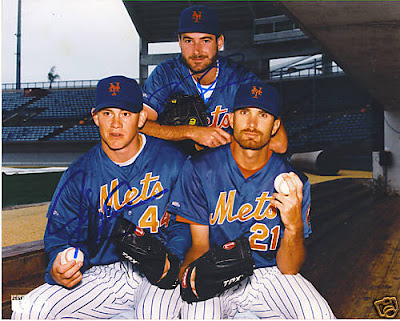
We swing back and forth from the past to the future like a pendulum with the fondness of memories and pride for our Orange and Blue past and the dismay and questions about our future. Met fans get a bad rap but we love our team and we want to see it become what we always thought it could be.
It’s hard to not wax nostalgic and think of the days of Doc K, Cone, Keith H, and the Straw man. I’m sure the years that our Amazins won the Championship in 86 and went to the Subway World Series in 2000 come to mind, too. Despite the way things have looked lately, I’ve seen quite a few reasons to be hopeful. I thought of a great example of the hope that the New York Met fan base had in a trio that left us way too soon: Generation K. I guess the interesting part of the story is why their careers with the team were so brief.
The trio known as Generation K (as in strikeout) was the cornerstone of a New York Mets dynasty that never was. Three young pitchers with superstar talent, Bill Pulsipher, Paul Wilson, and Jason Isringhausen were supposed to carry the Mets. They were supposed to bring the Mets back into contention and relevance, back to the World Series. With these guys as a symbol of the future, the Met fans had hope again, however, injuries put an end to the best laid plan.
Bill Pulsipher arrived first, in June of 1995, after pitching 200+ minor league innings as a 21-year old. Between the majors and the minors in 1995 he threw 218 more, but showed few ill effects, producing a 3.98 ERA. All those innings did take their toll, however, and he missed all of 1996 and most of 1997 with a torn elbow ligament. He was never the same, and after a brief comeback bid in 2001 it appeared his career has ended. The former whiz-kid’s final numbers? 13-19, 5.13 ERA. He spent time with Seattle and St. Louis before the end of his career.
Jason Isringhausen came next, in July of the same year, and was the Mets’ best pitcher down the stretch, with a 9-2 record and a 2.81 ERA. His 1996 was a struggle, with a pulled rib-cage muscle, bone spurs, and a torn labrum contributing to a 4.71 ERA. He had only six starts in 1997 and wasn’t very effective before going down with a broken wrist. He worked with Oakland and St. Louis most recently and was a saves leader in 2004. He recently signed a minor league contract with the Tampa Bay Rays for the 2009 season and was part of what was called a catastrophic performance by the Rays’ pen: Izzy faced 4 batters, gave up three straight walks and then the game-winning hit. Officially in the game, Izzy did not record an out. Gave up 1 hit, 3 walks, 0 strikeouts, 2 runs, both earned. He threw 23 pitches and only 9 were strikes – including the game-winning hit.
With the first pick in the 1994 free agent draft the Mets selected what many thought as the most promising member of the trio, college phenom Paul Wilson. Featuring a strong fastball/slider combo he made the majors in early 1996 after strong minor league numbers. He had often been accused of possessing poor mechanics, and the stress it put on his pitching arm haunted him early. After pitching 187 innings in the minors the year before, he spent much of 1996 on the DL. Wilson was considered by many to be a future Hall of Famer. He ended his career with Tampa Bay and Cincinnati. After spending all of the 2006 season in the minor leagues, Paul Wilson retired with a career Major League record of 40–58 and a 4.86 career ERA.
Generation K’s sad story has served as an effective warning against overworking young starters. Most pitching prospects are watched strictly on their pitch counts– very few are worked like Isringhausen, who twice threw over 130 pitches in 1996. Recent prospects like Jeremy Bonderman of the Detroit Tigers have been shut down after a specific amount of innings as well. Though Mets fans will always wonder what could have been, many teams have learned a lesson as a result of Generation K’s rise and fall.
In my opinion, it probably is not as easy as it sounds to temper enthusiasm for young pitching and using wisdom on how they are handled. We can debate which route is best but we are left wondering again what could’ve been. Hopefully, Met history doesn’t continue to repeat itself.














